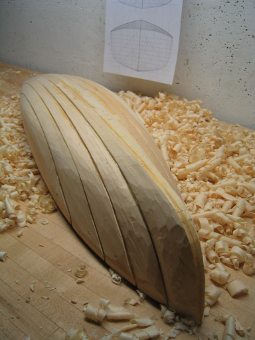Building model boats - Introduction
An introduction to model boat building – here is how to get started making your own RC or static model ship from kit or scratch.
When starting building model boats for the first time, I find the hardest part being able to help people choosing a model that correspond with their particular situation, be it their skills, tools, interests or place of construction. This page is meant as an overview to help you find your corner of this great hobby.

|
Most people seem to think building model boats from kits is a lot easier than building from scratch. I'm not sure if that is true. The most important advantage a kit has is that some parts are preformed and that it comes with instructions.
Some wooden model boat kits are of low quality, both in terms of material and instructions. A measly kit like that is a waste of time and will hinder you more than help.
Many model boats have been build from scratch as a first model. You just have to figure out what building method suits you best. A good way to start is with strip or sheet planked plank-on-bulkhead model boats. I'd recommend using balsa or basswood to limit the need for power tools.
If you happen to be an experienced woodworker with a shop area and some power tools, building bread-and-butter model boats may be a good option. It is a lot faster than strip planking in most cases.
Both methods discussed above will work if you are building a radio controlled model boat. One thing to consider is how quickly you want to get to sail it. If you are in hurry, consider a kit with a preformed hull from ABS or fiberglass.
If you’re just starting out, you may want to choose a relatively simple project. The quickest way to kill all enthusiasm is to get in way over your head. A sensible approach is to conquer a few skills with each successive model. This way you learn to tackle more and more difficult projects as your skills develop. At the same time you'll keep the cost down in the event you decide to abandon a project.
Static or Working Model
There are many purposes of building model boats. For the hobbyist it typically boils down to two categories:
Static Model Boats
The majority of model boats are built as static models. In essence that means they are for display only. They are typically more or less successful attempts at depicting a historic or fictitious vessel (such as from a movie). The majority of kits, regardless of material used, are for static display only. Oftentimes builders wish to convert a static kit to a working model to save time. Often, this is a mistake. Not only is the time and effort required often underestimated - static models are more often than not too heavy to do well as working models.
Working Model Boats
A working model boat is built to be run in water as its main purpose. To accomplish this, some compromises may have been made in scale detail or accuracy. There is an underlying tolerance in the model boat community for "semi scale" models as long as they are working models. In fact, most ready-made RC boats are entirely fictional.
Model Building Materials
Just about all model building materials you can think of has been used for model boats hull construction by now, anything from whale teeth to carbon fiber. The exotics aside, the most commonly used materials for building model boats include:
- Wood
- Plastic or resin
- Fiberglass (GRP, polyester or epoxy)
- Paper (kraftpaper, cardstock)
Model Boat Hull Design and Construction
The hull is probably the most important aspect of model boat building – and, in my opinion, the most fun to build! There are many methods and materials that can be used. For more, click the heading above.
Half Hull Model
If building model boats from a plan for the first time, a half hull model can be a good start. Essentially, it is half of a hull split down the middle, sometimes with wheel house and stumps for masts when relevant. It is then mounted on a board and hung on the wall for display.
This type of models was originally made by yacht, boat and ship builders and designers that didn’t have the expertise to design directly on the drawing board. It became their "master" from which plans were drawn up. Herreshoff, the famous American yacht designer, apparently designed all his boats this way.
Solid or laminated hardwood is the most common material, although planked or "crow's nest models" (bulkheads and incomplete planking) happen as well. One obvious benefit is that symmetry is a non-issue!
Radio Controlled Boats
Building RC boats gives the building a purpose beyond the building in itself. What sets radio controlled boat hulls apart is they have to be:
- Water proofed and sealed (obviously!)
- Built tough for transport and operation
- Be large (buoyant) enough to house RC gear, motors, steam plant etc.
It seems model boat fiberglass hulls are gaining more and more at the expense of vacuum formed ABS hulls among kit manufacturers. You can also make them yourself. This may make the most sense if you need several hulls of the same mold. There are some vendors who specialize in making hulls only, as opposed to a complete kit. This is typically a less expensive option than getting a full blown kit.
Toy Boat Building
Building toy model boats can be as involved as you want it to be. With the goal of building a toy as opposed to a scale model can take some of the pressure off for the result to be 100% realistic and allows infinite artistic license.





